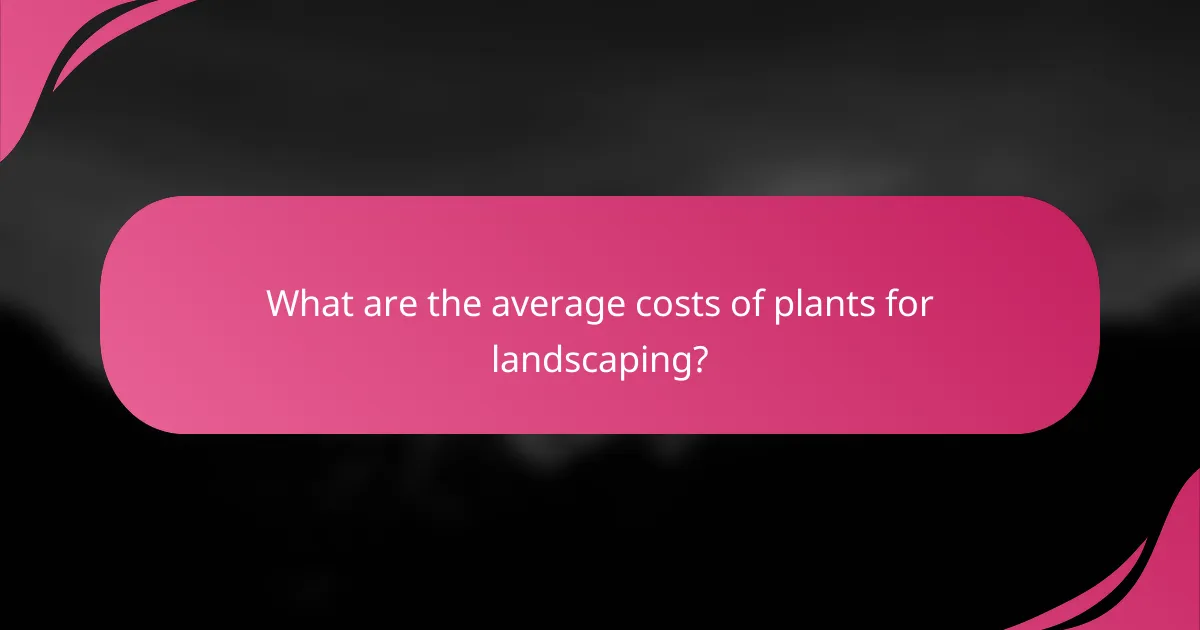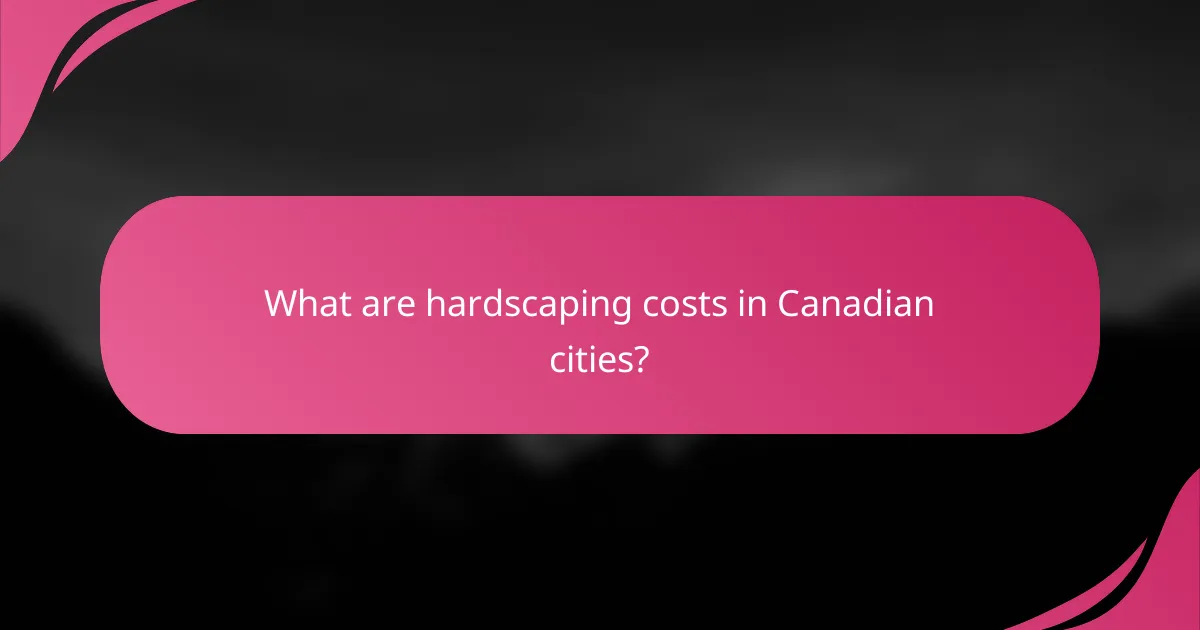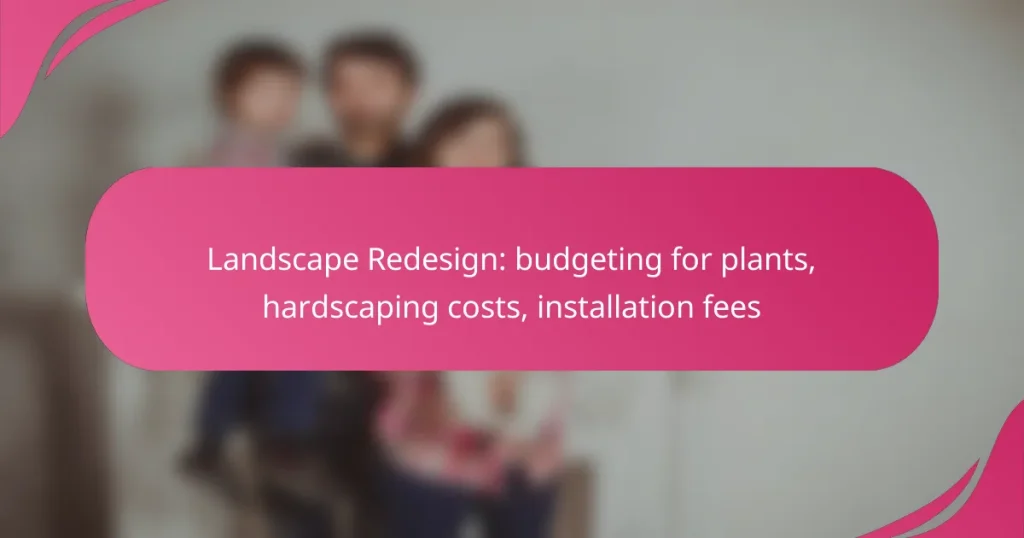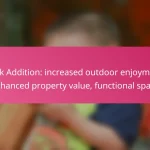When planning a landscape redesign, it’s essential to budget for various components, including plants, hardscaping, and installation fees. By understanding the costs associated with each element, homeowners can effectively allocate their budget and minimize the risk of unexpected expenses. From the price of plants to the complexity of hardscaping, careful financial planning is key to achieving a successful outdoor transformation.

How to budget for landscape redesign in Canada?
Budgeting for landscape redesign in Canada involves estimating costs for plants, hardscaping, and installation fees. Understanding these components will help you allocate your budget effectively and avoid unexpected expenses.
Estimate costs for plants
When estimating costs for plants, consider the types of plants you want, their sizes, and the quantities needed. Prices can vary widely; for instance, small shrubs might cost around CAD 20-50 each, while larger trees can range from CAD 100-500 or more.
Additionally, think about seasonal availability and local nurseries, as these factors can influence prices. It’s wise to create a list of desired plants and check multiple sources to find the best deals.
Calculate hardscaping expenses
Hardscaping expenses include materials like stone, brick, and concrete, as well as any structural elements such as patios or walls. The cost for hardscaping can range from CAD 30-100 per square foot, depending on the materials chosen and the complexity of the design.
Consider the long-term durability and maintenance of the materials when making your selections. For instance, natural stone may have a higher initial cost but could save money on maintenance over time compared to cheaper alternatives.
Include installation fees
Installation fees can significantly impact your overall budget, often ranging from CAD 50-100 per hour for professional landscapers. The total cost will depend on the scope of your project and the expertise required.
To manage these costs, obtain multiple quotes from contractors and clarify what is included in their services. Be cautious of unusually low bids, as they may indicate a lack of experience or hidden costs later on.

What are the average costs of plants for landscaping?
The average costs of plants for landscaping can vary significantly based on the type of plants chosen, their size, and the local market. Generally, homeowners can expect to spend anywhere from a few dollars for small annuals to several hundred dollars for larger, established perennials or specialty plants.
Perennial plants pricing
Perennial plants typically range from about $5 to $50 each, depending on their size and variety. Smaller perennials, such as daylilies or hostas, usually cost less, while larger or more unique varieties can be more expensive. When budgeting, consider purchasing in bulk, as many nurseries offer discounts for larger quantities.
Additionally, consider the long-term investment of perennials, as they return year after year, potentially reducing future planting costs. This makes them a cost-effective choice for many landscaping projects.
Annual plants pricing
Annual plants generally cost between $3 and $30 each, with prices varying based on the species and size. Common annuals like petunias or marigolds are often on the lower end of the price spectrum, while more exotic varieties can be pricier. These plants need to be replanted each year, which can add to overall landscaping costs over time.
When planning for annuals, consider seasonal sales or local garden centers that may offer promotions, especially in the spring. This can help stretch your budget further.
Native plants cost benefits
Native plants often come with cost benefits, as they are well-adapted to local climates and require less maintenance and water once established. Prices for native plants can range from $5 to $40, depending on the species and size. Choosing native options can reduce long-term costs related to irrigation and pest management.
Incorporating native plants into your landscape can also enhance local biodiversity, providing habitats for wildlife. Many local governments and organizations offer incentives or rebates for using native plants, which can further offset initial costs.

What are hardscaping costs in Canadian cities?
Hardscaping costs in Canadian cities can vary significantly based on materials, labor, and project complexity. Homeowners should anticipate spending anywhere from a few thousand to tens of thousands of Canadian dollars, depending on the scope of their landscaping project.
Patio installation costs
The cost of patio installation in Canada typically ranges from CAD 50 to CAD 150 per square foot, depending on the materials used. For example, concrete patios may be on the lower end, while natural stone can be considerably more expensive.
When budgeting for a patio, consider additional expenses such as site preparation, drainage solutions, and labor. Hiring a professional can increase costs but may ensure a higher quality and more durable installation.
Walkway material prices
Walkway material prices can vary widely, with options ranging from gravel at approximately CAD 10 to CAD 30 per square foot to more upscale materials like pavers or stamped concrete, which can cost CAD 30 to CAD 100 per square foot. The choice of material will impact not only the initial cost but also long-term maintenance and durability.
When selecting materials, consider the climate and foot traffic in your area. For instance, porous materials may be better for regions with heavy rainfall to prevent water pooling.
Retaining wall expenses
Retaining wall expenses in Canada generally range from CAD 20 to CAD 50 per square foot for standard materials like concrete blocks. More decorative options, such as natural stone, can push costs to CAD 50 to CAD 100 per square foot.
Factors influencing the cost include wall height, length, and the need for drainage systems. It’s essential to consult with a professional to ensure proper design and compliance with local regulations, especially for taller walls that may require permits.

How to choose the right plants for your landscape?
Choosing the right plants for your landscape involves considering factors like climate, maintenance, and aesthetics. Selecting plants that thrive in your local environment ensures a sustainable and visually appealing garden.
Consider climate suitability
Climate suitability is crucial when selecting plants for your landscape. Choose species that are well-adapted to your local climate zone, which can range from temperate to tropical. For example, in the United States, the USDA Plant Hardiness Zone Map can guide you in selecting plants that will survive and thrive in your area.
Additionally, consider factors like rainfall, temperature extremes, and soil type. Native plants often require less water and maintenance, making them a practical choice for many gardens.
Assess maintenance requirements
Maintenance requirements vary widely among different plant species. Some plants may need regular pruning, fertilization, or pest control, while others are low-maintenance and can thrive with minimal intervention. Before making a selection, evaluate how much time and effort you can realistically dedicate to plant care.
For instance, succulents and ornamental grasses typically require less upkeep compared to flowering perennials or shrubs. Creating a maintenance schedule can help you manage your landscape effectively.
Evaluate aesthetic appeal
Aesthetic appeal is an important factor in plant selection. Consider the colors, textures, and shapes of plants to create a visually pleasing landscape. Mixing different plant types can enhance the overall look of your garden, providing year-round interest.
Think about seasonal changes as well; some plants bloom in spring, while others provide color in fall. Using a combination of evergreen and deciduous plants can ensure your landscape remains attractive throughout the year.

What factors influence installation fees?
Installation fees for landscape redesign are influenced by various factors, including labor costs, design complexity, and site preparation needs. Understanding these elements can help you budget effectively for your project.
Labor costs in urban areas
Labor costs can vary significantly between urban and rural areas. In cities, where demand for skilled labor is high, you might expect to pay 20-50% more for installation services compared to less populated regions.
Additionally, local regulations and the cost of living can impact labor rates. Always obtain multiple quotes from contractors to ensure competitive pricing.
Complexity of design
The complexity of your landscape design directly affects installation fees. Intricate designs with multiple features, such as water elements, varied plantings, and hardscaping, typically require more time and expertise, leading to higher costs.
For example, a simple garden bed installation may cost a few hundred dollars, while a comprehensive design with pathways, lighting, and irrigation could run into the thousands. Clearly outline your vision to get accurate estimates.
Site preparation requirements
Site preparation is a crucial step that can significantly influence installation fees. If your site requires extensive grading, soil amendments, or debris removal, these additional tasks will add to the overall cost.
Consider factors such as existing vegetation, drainage issues, and accessibility. A well-prepared site can streamline installation and reduce labor time, ultimately saving you money.

What are the benefits of hiring a landscape designer?
Hiring a landscape designer can significantly enhance the aesthetic and functional aspects of your outdoor space. They bring expertise in plant selection, hardscaping, and overall design that can save you time and money while ensuring a cohesive look.
Budgeting for plants
When budgeting for plants, consider factors such as the type of plants, their size, and the quantity needed for your landscape. Native plants often require less maintenance and water, making them cost-effective choices in the long run.
On average, homeowners might spend anywhere from a few hundred to several thousand dollars on plants, depending on the scale of the project. It’s wise to allocate around 10-20% of your total landscape budget specifically for plant materials.
Hardscaping costs
Hardscaping costs can vary widely based on materials and design complexity. Common hardscape elements include patios, walkways, and retaining walls, with costs typically ranging from $15 to $50 per square foot, depending on the materials used.
When planning your budget, consider both the installation costs and the long-term maintenance of hardscape features. Opting for durable materials may have a higher upfront cost but can save money over time due to lower maintenance needs.
Installation fees
Installation fees for landscaping projects can vary based on the complexity of the work and the region. On average, professional installation can range from $50 to $150 per hour, depending on the contractor’s experience and local market rates.
To manage installation costs effectively, obtain multiple quotes from different contractors and ensure they provide detailed breakdowns of their fees. This transparency can help you make informed decisions and avoid unexpected expenses during the project.


